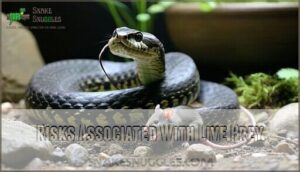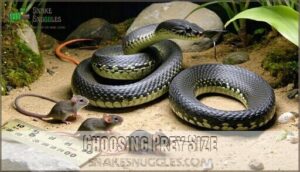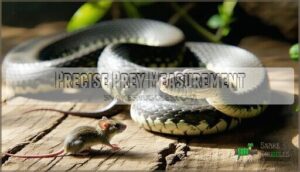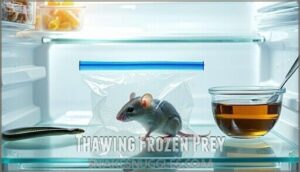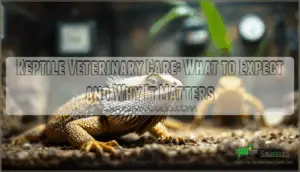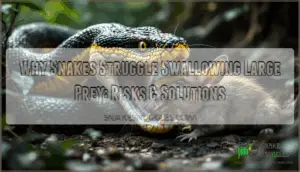This site is supported by our readers. We may earn a commission, at no cost to you, if you purchase through links.
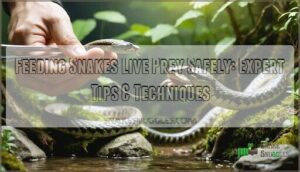 You’ll master feeding snakes live prey safely by selecting appropriately sized prey, monitoring feedings closely, and using feeding tongs to prevent bites.
You’ll master feeding snakes live prey safely by selecting appropriately sized prey, monitoring feedings closely, and using feeding tongs to prevent bites.
Choose prey no larger than your snake’s thickest body section, ensuring it’s healthy and disease-free.
Always supervise live feeding sessions, as rodents can injure snakes through defensive bites or scratches. Remove uneaten prey within 30 minutes to prevent stress and potential harm.
Consider your snake’s species-specific needs—some thrive on live prey’s mental stimulation, while others do fine with frozen alternatives. The key lies in balancing natural hunting behaviors with safety protocols that protect both predator and prey.
Table Of Contents
- Key Takeaways
- Live Prey Benefits Explained
- Risks Associated With Live Prey
- Prey Selection Guidelines
- Safe Feeding Techniques
- Live Vs Frozen Prey Considerations
- Frequently Asked Questions (FAQs)
- Should you feed live prey to snakes?
- Is it better to feed snakes live or frozen?
- Is it illegal to feed live mice to snakes in the US?
- How often should I supervise live prey feeding sessions?
- What temperatures are safest for live prey storage?
- Can snakes refuse live prey after frozen feeding?
- How do I humanely euthanize injured live prey?
- Conclusion
Key Takeaways
- Choose prey that’s 10-15% of your snake’s body weight and no wider than its thickest section to prevent choking and digestive issues.
- Always supervise live feeding sessions and use feeding tongs to maintain a safe distance, as defensive rodents can inflict serious injuries within minutes.
- Remove uneaten prey within 30 minutes to prevent stress and potential harm to your snake from continued defensive attacks.
- Consider frozen-thawed alternatives since they eliminate injury risks while maintaining nutritional value, with 40% of live prey causing defensive bite injuries.
Live Prey Benefits Explained
Live prey offers your snake several natural benefits that frozen alternatives can’t match.
When you feed live rodents, you’re providing fresh, whole-food nutrition that boosts immune function, enhances vitamin absorption, and stimulates your snake’s hunting instincts.
Live feeding delivers nature’s perfect nutrition package—fresh prey that awakens your snake’s primal hunting instincts while providing unmatched nutritional benefits.
While offering essential mental enrichment.
Boosting Immune System
Live prey provides nutrient-rich meals that naturally boost your snake’s immune system through fresh, whole-food nutrition.
When you feed live prey, you’re delivering essential vitamins and minerals in their most bioavailable form.
This immune boost helps your snake fight off diseases and maintain peak health, making live feeding particularly beneficial for snakes with compromised immune systems or those requiring enhanced snake nutrition.
Increased Vitamin Absorption
When you feed fresh prey, you’re giving your snake a vitamin boost that frozen alternatives can’t match.
Fresh nutrition from whole food sources provides nutrient-rich meals with enhanced bioavailability. Living prey maintains prime vitamin A levels and nutrient density that support your snake’s dietary needs.
This natural approach delivers a balanced diet with vitamins intact. Feeding snakes involves understanding the benefits of live prey feeding to guarantee a healthy and stimulating environment.
Strengthening Hunting Instincts
When you offer live prey, you’re basically providing your snake with a masterclass in hunting tactics.
The movement triggers their natural behavior patterns, sharpening snake reflexes that might otherwise grow dull in captivity.
This prey stimulation awakens instinct development that’s been hardwired for millions of years.
Your snake’s natural hunting instincts get a proper workout, making feeding live prey an excellent way to maintain their predatory edge through proper snake feeding techniques.
Mental Stimulation
Your snake’s brain craves Environmental Enrichment through live prey encounters.
This Sensory Stimulation triggers complex Snake Behavior patterns, promoting Cognitive Development as your pet analyzes moving targets.
The mental workout strengthens natural hunting instincts while providing essential Stress Reduction.
Think of it as CrossFit for serpents—each feeding session becomes an engaging puzzle that keeps your snake sharp and behaviorally healthy.
Risks Associated With Live Prey
While live prey offers nutritional benefits that can enhance your snake’s health, it also presents significant risks that require careful consideration.
Understanding these potential dangers helps you make informed decisions about your pet’s feeding routine and implement proper safety measures to ensure complete concepts are considered for your snake’s well-being, including the importance of informed decisions.
Injury Risks From Defensive Bites
While live prey offers benefits, defensive bites pose serious risks you can’t ignore. Cornered rodents fight back with surprising ferocity, leaving lasting damage on your snake.
When cornered, prey animals unleash desperate fury that can permanently scar your snake.
Common defensive bite injuries include:
- Puncture wounds – Deep holes from rodent teeth that penetrate muscle and organs
- Eye damage – Scratches or bites that can cause permanent blindness
- Facial lacerations – Cuts around the mouth and jaw requiring surgical repair
- Spinal injuries – Bites near the neck that damage nerves and mobility
- Infected wounds – Bacteria from rodent saliva causing serious secondary infections
Even experienced handlers report bite wounds in up to 25% of snakes fed live rodents. These snake injuries aren’t just scratches—they’re genuine medical emergencies requiring immediate veterinary intervention.
Proper prey handling and snake safety precautions can prevent most incidents, but defensive bites remain an ever-present threat that makes injury prevention your top priority. To minimize risks, to guarantee a safe experience, understand feeding your snake and take necessary precautions to ensure a safe feeding environment.
Disease Transmission
Beyond bite wounds, rodent borne pathogens pose serious threats to both you and your snake.
Salmonella risk increases dramatically with live prey – these bacteria naturally inhabit rodent intestines.
Zoonotic diseases like rat-bite fever and lymphocytic choriomeningitis virus can jump from prey to handler through contact with urine or feces.
Parasite control becomes challenging when live rodents introduce nematodes and pentastomids.
Infection prevention requires strict hygiene protocols and regular veterinary monitoring for healthy snake health.
Understanding zoonotic disease risks is vital for safe handling and care of snakes fed live prey.
Ethical Concerns
Many snake owners grapple with Animal Welfare and Prey Rights when choosing live feeding methods.
The ethical concerns surrounding snake feeding ethics center on whether it’s morally justifiable to offer live prey without escape options.
This creates Snake Stress for both predator and prey, raising questions about Humane Treatment.
While some argue it mirrors natural behavior, others view it as unnecessary cruelty when frozen alternatives exist, making Owner Ethics a personal consideration.
Parasite Infestations
Rodents carrying parasites pose significant threats to your snake’s health.
Mite infestations and tick control become major concerns when using live prey from unverified sources.
Proper rodent screening and parasite testing help identify disease transmission risks before feeding.
Snake parasites like intestinal worms often hitchhike on live prey, establishing dangerous infestations in your pet’s system.
Prey Selection Guidelines
You’ll need to select prey that matches your snake’s size and dietary requirements to guarantee safe, effective feeding.
Getting the measurements right prevents choking hazards and digestive issues that can turn feeding time into an emergency vet visit, which is why selecting the right prey is crucial for safe feeding.
Choosing Prey Size
When selecting prey size for feeding snakes safely, you’ll want to follow the golden rule: prey weight should equal 10-15% of your snake’s body weight.
The prey diameter shouldn’t exceed your snake’s thickest section—think of it like trying to swallow a golf ball.
This feeding ratio prevents choking hazards and digestive issues.
Size guidelines guarantee your snake can handle live prey handling without strain, making snake feeding safety your top priority.
Understanding the correct prey size charts is vital for maintaining a healthy snake.
Species-Specific Diet Charts
Your snake’s blueprint for success lies in understanding species-specific dietary needs.
Ball pythons thrive on mice progressing to rats, while corn snakes follow similar prey size progression.
Garter snakes prefer fish and amphibians, requiring calcium supplementation.
King snakes accept diverse prey including rodents and birds.
Proper feeding guides guarantee the best snake nutrition by matching prey size to species requirements and growth stages.
Understanding the proper snake diet guide is vital for providing a balanced and nutritious diet for your pet snake.
Nutritional Balance
You’ll need to balance multiple nutritional needs when selecting prey for your snake.
Protein sources should match your snake’s species-specific diet requirements, while vitamin needs vary between rodent-eating and fish-eating species.
Mineral balance affects bone health, making calcium-rich prey important.
Monitor caloric intake to prevent obesity.
Dietary variety supports ideal snake nutrition and prevents deficiencies in your pet’s balanced diet.
Precise Prey Measurement
Getting the prey size just right isn’t rocket science, but it’s vital for your snake’s health and safety.
Here’s your measurement checklist:
- Measure your snake’s thickest body section – this determines maximum prey width
- Weigh prey items – aim for 10-15% of your snake’s total body weight
- Check prey length – should be manageable for your snake’s jaw capacity
- Document feeding ratios – track what works best for weight management
Proper prey size guidelines prevent choking, regurgitation, and digestive issues while ensuring ideal snake nutrition through effective meal planning.
Safe Feeding Techniques
You’ll need to master proper feeding techniques to keep both you and your snake safe during live prey feeding sessions.
Whether you’re handling live rodents or preparing frozen alternatives, the right approach prevents injuries and guarantees your snake gets the nutrition it needs.
Handling Live Prey
Effective prey handling guarantees both your safety and your snake’s well-being. You’ll need secure containers and proper tools to manage live prey items safely.
| Handling Step | Safety Protocol | Equipment Needed |
|---|---|---|
| Transport | Use escape-proof containers with ventilation | Secure transport box |
| Storage | Keep prey in appropriate enclosures until feeding | Separate housing setup |
| Feeding | Never handle prey directly with hands | Long feeding tongs |
| Supervision | Monitor entire feeding process closely | Timer for tracking |
| Cleanup | Remove any uneaten prey immediately | Gloves and disposal bag |
Always use feeding tools rather than your hands when presenting live prey items to your snake. This prevents accidental bites and maintains proper distance during the feeding process. Using the right feeding tongs equipment is vital for a safe and successful feeding experience.
Thawing Frozen Prey
Proper thawing prevents bacterial growth and guarantees safe feeding practices.
You’ll want to defrost frozen prey in your refrigerator overnight using sealed bags.
This controlled thawing method maintains prey quality while eliminating harmful bacteria.
Once thawed, warm the prey in tepid water to trigger your snake’s feeding response.
Effective defrosting techniques make preparing frozen prey straightforward and safe.
Utilizing a reliable frozen prey thawing device can also be beneficial for snake owners, ensuring safe feeding practices.
Simulating Movement
Movement transforms frozen prey into irresistible targets.
Visual and motion cues substantially increase strike rates, especially for reluctant feeders shifting from live prey.
Essential snake feeding tips for simulating natural prey movement:
- Walk prey slowly across the enclosure floor using feeding tongs
- Create zigzag patterns with sudden stops to mimic real escape behaviors
- Twitch periodically to replicate struggling movements that trigger constriction
- Vary speed and direction – predictable patterns reduce feeding response
This prey movement technique safely activates hunting behavior while eliminating live prey handling risks.
Your snake’s tongue-flicking and tracking behaviors will intensify as natural predatory instincts engage through controlled snake stimulation.
Using Feeding Tongs
When feeding live prey, you’ll need feeding tongs to maintain a safe distance between your hands and the snake.
Quality tongs prevent accidental bites and eliminate hand-scent transfer that could trigger feeding responses.
The right tongs give you precise prey control while protecting both you and your snake during feeding interactions.
Using the correct safe snake handling techniques is essential for a stress-free experience.
| Tong Feature | Safety Benefit |
|---|---|
| Length (12+ inches) | Prevents accidental strikes during feeding |
| Textured Tips | Secure prey grip reduces dropping incidents |
| Stainless Steel | Easy sanitization prevents disease transmission |
Live Vs Frozen Prey Considerations
You’ll need to weigh several factors when choosing between live and frozen prey for your snake.
Research shows that over 80% of herpetologists recommend frozen-thawed rodents due to substantially lower injury risks.
While live prey can stimulate natural hunting behaviors that some snakes prefer, with lower injury risks being a significant consideration for many owners.
Safety Comparison
Your snake’s safety depends on making informed choices about prey types.
Frozen prey eliminates bite risks and disease transmission, while live prey increases injury likelihood despite potential appetite stimulation.
Risk assessment reveals frozen options provide superior injury prevention and disease control.
| Safety Factor | Live Prey | Frozen Prey |
|---|---|---|
| Injury Risk | High (40% bite rate) | None |
| Disease Control | Poor (parasites/infections) | Excellent |
| Feeding Safety | Requires monitoring | Stress-free |
Nutritional Value
Looking at the nutritional value between live and frozen prey, you’ll find minimal differences in essential nutrients.
Both options deliver complete protein sources and mineral content your snake needs.
| Nutrient Type | Live Prey | Frozen Prey |
|---|---|---|
| Protein Content | 61-73% | 60-72% |
| Vitamin E | Higher levels | Degrades after 3+ months |
| Calcium/Phosphorus | Identical ratios | Identical ratios |
The key difference lies in vitamin E degradation during long-term freezing.
Fresh prey maintains higher vitamin levels, but frozen prey stored properly for under three months retains nearly identical nutritional value.
Your snake’s caloric intake and vitamin needs remain satisfied with either choice, making nutritional considerations less critical than safety factors when deciding between live and frozen options.
Convenience and Humane Factors
Convenience separates frozen-thawed prey from live feeding in practical terms.
You’ll spend less time sourcing, storing, and supervising meals with frozen options.
Humane Treatment becomes straightforward when prey dies instantly rather than experiencing prolonged stress.
Ethical Feeding considerations favor pre-killed rodents, eliminating suffering during Snake Welfare interactions.
The use of frozen prey reduces the risk of disease transmission issues, making it a safer choice for snake owners.
| Factor | Live Prey | Frozen-Thawed |
|---|---|---|
| Storage | Requires separate housing, food, water | Freezer space only |
| Preparation Time | Immediate supervision needed | 30-60 minutes thawing |
| Stress Level | High for prey animal | None for prey |
| Availability | Limited by pet store hours | Always available |
| Cost | Higher ongoing expenses | Lower long-term costs |
Snake Preferences and Owner Convenience
Understanding your snake’s individual preferences can make or break your feeding strategy.
Some snakes are picky eaters who’ll only accept live prey, while others readily take frozen-thawed options.
Your experience level and available time also matter substantially.
| Factor | Live Prey | Frozen Prey |
|---|---|---|
| Snake Behavior | Stimulates hunting instincts | Requires scenting techniques |
| Owner Experience | Needs supervision skills | Beginner-friendly approach |
| Pet Convenience | Weekly prey sourcing | Bulk storage possible |
Consider your snake’s feeding history and your comfort level with live prey feeding methods for ideal snake welfare.
Frequently Asked Questions (FAQs)
Should you feed live prey to snakes?
While many think live prey is "more natural," you shouldn’t feed it to your snake.
Frozen-thawed prey is safer, eliminating injury risks from defensive bites that affect 25% of snakes fed live rodents.
Is it better to feed snakes live or frozen?
Frozen-thawed prey is safer and more practical for most snake owners.
You’ll eliminate injury risks from defensive rodents while maintaining proper nutrition.
Live prey can bite, scratch, or transmit diseases to your snake, which makes frozen-thawed prey a better option for ensuring the health and safety of your pet.
Is it illegal to feed live mice to snakes in the US?
Feeding live mice to snakes isn’t illegal in the US.
Live prey is being fed all the time to snakes. It isn’t illegal to feed.
However, most experts recommend frozen-thawed prey since it’s safer for your snake and eliminates injury risks from defensive bites.
How often should I supervise live prey feeding sessions?
You should supervise live prey feeding sessions continuously throughout the entire process.
Never leave a snake unattended with live prey, as defensive rodents can inflict serious injuries within minutes of being introduced.
What temperatures are safest for live prey storage?
Store live prey at 65-75°F with proper ventilation.
You’ll need consistent temperatures to prevent stress and disease.
Too hot causes dehydration; too cold weakens immunity.
Use thermostats for precise control and monitor daily to ensure the health and well-being of the live prey, maintaining optimal conditions with proper ventilation.
Can snakes refuse live prey after frozen feeding?
Like a magnet suddenly losing its pull, you’ll find that snakes accustomed to frozen prey can absolutely refuse live prey afterward.
Their feeding preferences adapt, and they may show reluctance or complete rejection when presented with moving rodents again, as their preferences have completely changed to favor frozen over live prey.
How do I humanely euthanize injured live prey?
Quick cervical dislocation works best—grasp the head and body, then swiftly pull and twist in opposite directions.
This method’s instantaneous and prevents suffering.
Alternatively, use CO2 chambers for multiple rodents, though they’re slower but equally humane when done correctly.
Conclusion
Research shows that 40% of snake owners switch from live to frozen prey within two years due to safety concerns.
Successfully feeding snakes live prey safely requires constant vigilance, proper prey selection, and swift intervention when needed.
You’ve learned the techniques to minimize risks while respecting your snake’s natural behaviors.
Remember that feeding tongs aren’t just tools—they’re your snake’s lifeline during feeding sessions.
Whether you choose live or frozen prey ultimately depends on your comfort level and your snake’s specific needs.
- https://www.sciencedirect.com/science/article/pii/S0378113509006154?via%3Dihub
- https://www.cdc.gov/rodents/diseases/direct.html
- https://wwwnc.cdc.gov/eid/article/23/4/16-1987_article
- https://vetmed.illinois.edu/pet-health-columns/pet-snakes-diet-dead-alive/
- https://www.rodentpro.com/informationcenter/resources/feeding-frozen-vs-live-reptiles

